Cory Huff's Blog: The Abundant Artist Goodreads blog, page 14
February 15, 2019
Member of the Week: Nina Bonos, Painting Vibrant, Sacred Forces.
This week’s featured Association member is painter Nina Bonos.
TAA: How would you describe your art to your ideal collector?
Nina: Vibrant, watercolor and mixed media paintings–many with Jewish themes, teachings and symbols. Most popular is my Seven Sacred Species Collection depicting pomegranates, grapes, olives, figs, dates, wheat and barley. These species are common to the holy land as well as Sonoma Wine Country where I live and paint. I also create Wine Country Landscape and abstract Forces of Nature collections.
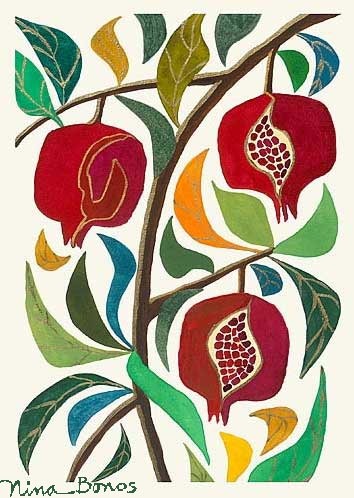 “Torah Mantle Detail: Pomegranate Trio”, Nina Bonos
“Torah Mantle Detail: Pomegranate Trio”, Nina Bonos
TAA: What motivates you during slow seasons?
Nina: Choosing to work in series, I have familiar subjects guiding my painting adventures. As seasons change, I periodically return to similar subject matter. Depicting aspects of the changing seasons helps center me and makes me continually appreciate and celebrate nature.
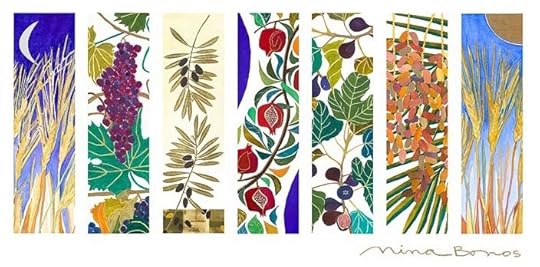 “Torah Mantle: Seven Sacred Species Window”, Nina Bonos
“Torah Mantle: Seven Sacred Species Window”, Nina Bonos
TAA: How did you settle on your current way of working? (How did you narrow your focus?)
Nina: My work is a natural evolution of 45 years of meditation and prayer; and it unfolded through my life’s journeys and experiences.
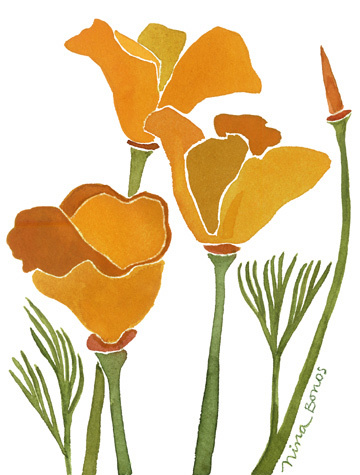 “California Poppies”, Nina Bonos
“California Poppies”, Nina Bonos
TAA: What is one mistake you’ve learned an important lesson from in your business?
Nina: Don’t make things too complicated. Focus. Listen.
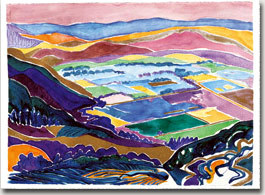 “Sonoma Fertile Valley”, Nina Bonos
“Sonoma Fertile Valley”, Nina Bonos
TAA: What was your greatest success from the past year?
Nina: During my 31st Art Trails Open Studio in October 2018, several families who lost homes during the 2017 Santa Rosa, CA wildfires came to me and purchased paintings and prints replacing art collections lost when their homes burned. This was not only financially successful, it was gratifying working with art collectors who want and need soul nourishment.
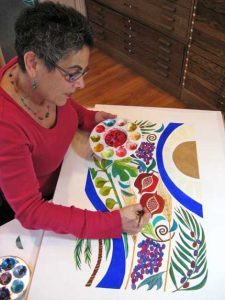 Nina Bonos creates bold watercolor paintings and mixed media collages in my own distinct, contemporary style. She gets her inspiration from the land and its bounty; from landscapes both real and imagined. She is thrilled to live in Sonoma County.
Nina Bonos creates bold watercolor paintings and mixed media collages in my own distinct, contemporary style. She gets her inspiration from the land and its bounty; from landscapes both real and imagined. She is thrilled to live in Sonoma County.
Nina has won many honors for her fine art including First Place at the Wine Country Artist’s Show in St. Helena, California, and Second Place National Award from the American Jewish Press in Chicago. Her designs are widely published in newspapers and magazines and appear on clothing, accessories, greeting cards and ceramic tiles.
You can see more of Nina’s work at http://ninabonos.com
The post Member of the Week: Nina Bonos, Painting Vibrant, Sacred Forces. appeared first on Online Marketing for Artists.
February 13, 2019
Should You Exhibit in That Art Show? 10 Questions to Ask
Note: Some of this content is taken from a private masterclass available to members of The Abundant Artist Association.
If you’ve been a working artist for a while, it’s likely that you’ve attended at least one art show that turned out to be a dud. Perhaps you got invited to a show in your hometown that ended up being much smaller than you anticipated, or a show you expected to make a nice profit from ended up failing miserably at advertising and you went home in the red. A third option, and one that is all too common, is a show that is well attended and well-advertised, but still not the right show for you and your art.
Not only can these negative art show experiences harm your morale and make you question your abilities, but they can also make a serious impact on your business. Too many bad shows in a row, and you may find yourself in a bad way.
Before you make the decision to pay the application fee for a new show, there are two kinds of questions to ask. The first group is questions to ask yourself about your art, your business, and your goals. The second group is questions to ask specifically about the art show in question. Once you’ve answered these questions, you’ll be in a position to confidently decide whether or not you should attend any art show.
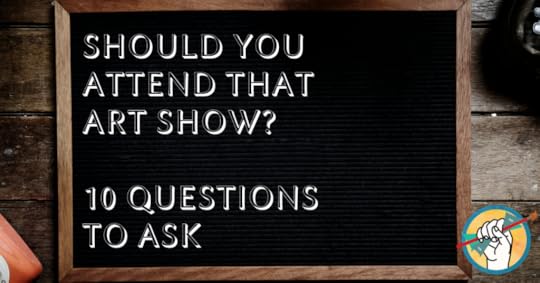
Questions to Ask Yourself:
What are my personal goals/reasons for exhibiting in this show? Are they in alignment with my business goals? Take a close look at your reasons for wanting to exhibit- is it a show you always imagined yourself being a part of? Do you have artist friends who speak highly of the show? Have you attended the show but never exhibited before? None of these reasons are wrong, but you need to be aware of any emotions that may be underlying your choice to exhibit and whether they serve the ultimate goals of your business. Ultimately exhibiting should be a practical business decision and not just an emotional one.
What are my business goals for attending this show? How many new prospects do you hope to come away with? How much profit do you hope to make?
Can I afford it? Art fairs and shows can come with a lot of hidden costs. Make sure you know how much an art show costs before you apply.
Am I prepared, or can I get prepared in time? Do you have enough original & print inventory in stock? Are you prepared with an effective means of capturing contact information for your new prospects? Do you have a way to accept credit cards? Do you have signage and booth materials ready to go, or can you have them ready in time?
Questions to Ask the Art Show:
Do your homework well in advance of deciding whether to exhibit. Reach out to the art show itself to answer these questions, and if at all possible, find artists who have shown there before and would be willing to share their experiences with you.
Where is it located? Can you afford the costs of travel, lodging, and food? Is it being held in a place likely to garner lots of attention, foot traffic, etc?
How old is it? How long has the show been around? Is it a brand new show that no one knows exists, or is it a highly anticipated annual show with lots of advertising in advance?
What do other artists have to say about the experience of showing there? Have any fellow artists had an exceptionally good or bad experience? Listen to what they have to say (and remember to take it with a grain of salt.)
How are they advertising? Is the show putting a significant portion of their budget toward making sure people know it’s happening? Nothing is more demoralising than crickets at a show opening.
Is there a limitation to the medium, style, theme of art being shown?
How much does it cost, and does the show take a commission?
Once you’ve determined whether the art show is a good match for your goals, your art, and your budget, you can move on to the planning. Planning for an art show of course involves preparing your budget, your booth materials and your artwork. But just as important, if not more important, is how you plan to follow up with the prospects you connect with at the show. For more essential tips on preparing for art shows, check out The 3 Most Important Tips for Selling at Art Shows.
What criteria do you use for deciding which art shows to attend? Let us know in the comments!
The post Should You Exhibit in That Art Show? 10 Questions to Ask appeared first on Online Marketing for Artists.
February 8, 2019
Member of the Week- Will Enns: Lifting Spirits with Paintings of Spirits
This week’s featured Association member is Will Enns.
TAA: How would you describe your art to your ideal collector?
Will: My art is not unusual; It’s unique. My ideas are unique. The result is unique. If you want vanilla, look elsewhere. My art lifts people’s spirits. I see it every day. People look at my art, they smile, they laugh, they start talking.
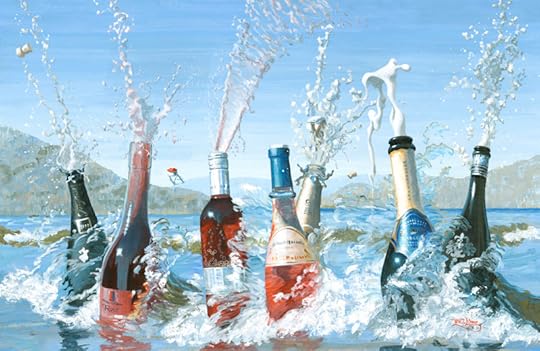 “Topless at the Beach”, Will Enns
“Topless at the Beach”, Will EnnsTAA: What motivates you during slow seasons?
Will: I do this full time. If I’m not working on something, It’s time to die.
This IS the slow season, I am finalizing my kid’s book “The Crazy Zoo Tangle.” I wrote it, and have just finished the illustrations. Next, there is the promotion. When that’s done, there are a bunch more wine paintings in the pipeline. By then it’s fall, and time to replenish all the venues that sell my art and funnel buyers to my studio, which is where most of the sales happen. There is no slow time, only ad infinitum. I need a rest from the slow season.
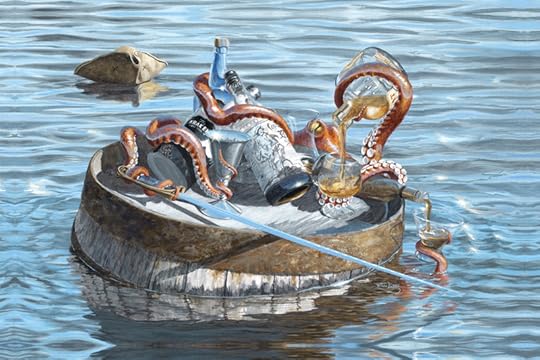 “Mutiny”, Will Enns
“Mutiny”, Will EnnsTAA: How did you settle on your current way of working? (How did you narrow your focus?)
Will: I painted a bunch subjects such as cars, landscape, old world, fashion, etc., in an attempt to identify what sells. Wine art sells where I live, so wine art is what I paint the most of.
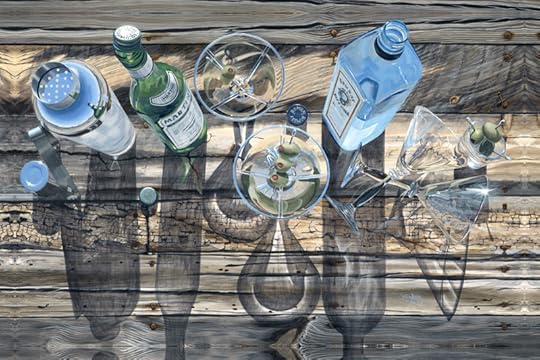 “Shaken not stirred”, Will Enns
“Shaken not stirred”, Will EnnsTAA: What is one mistake you’ve learned an important lesson from in your business?
Will: It’s a huge mistake to pay attention to what other artists are doing. Far better to pay attention to what buyers want to own.
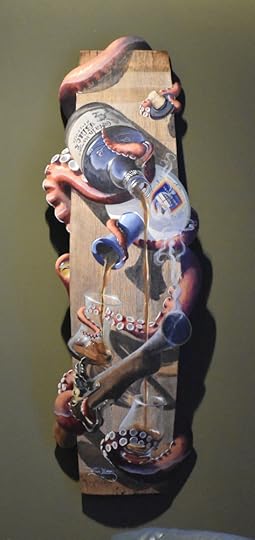 “Why the rum is gone”, Will Enns
“Why the rum is gone”, Will EnnsTAA: What was your greatest success from the past year?
Will: Learning the up-sell. Fully 50% of my buyers spend another 1-200 if I make them an offer on a second print at a discount.
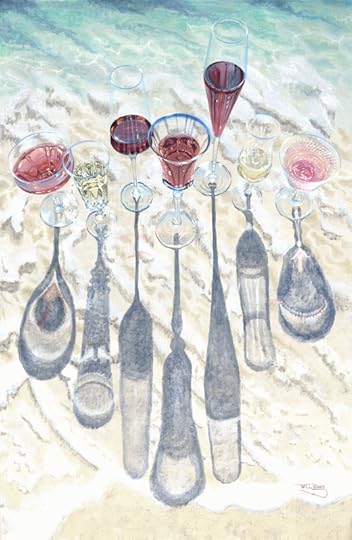 “5 o’Clock Somewhere”, Will Enns
“5 o’Clock Somewhere”, Will Enns

Will Enns once a drywall contractor. Later, he bought a motel with his wife Jennifer. While inn-keeping provides ample material for acerbic commentary, it also leaves free time during the long winters, so in 2001, Will began drawing seriously. He soon came under the tutelage of Ben Crane, a nationally published illustrator. Within a year, he was selling story illustrations to several magazines, and by 2003, he was making cover art for Cars Magazine (then known as Canadian Technician.) Will has worked in watercolor and digital media, but prefers acrylics for their forgiving nature and durability. His work has been prominently featured on the cover of Okanagan Life magazine, on the Big Screen, Wine Labels, and in other venues that fail to spring to mind. Will lives and paint in Summerland BC, where Jennifer encourages his various and frequently ridiculous endeavors, when not too busy chortling over them. You can see more of his work at his website, http://willenns.com
The post Member of the Week- Will Enns: Lifting Spirits with Paintings of Spirits appeared first on Online Marketing for Artists.
February 6, 2019
How Much Does it Cost to Attend an Art Fair?
How much does the average art fair cost? Beginning to exhibit at fairs and shows is an exciting new step in your art career. So exciting, in fact, that it can be easy to forget about all the hidden costs and fees associated with it. We’ve put together this list of costs you can expect for the average local/regional art fair to help you be better prepared, so you can plan your budget accordingly and hopefully leave the show with a profit. We also asked for input from artists in The Abundant Artist Association on how much they tend to spend per show.
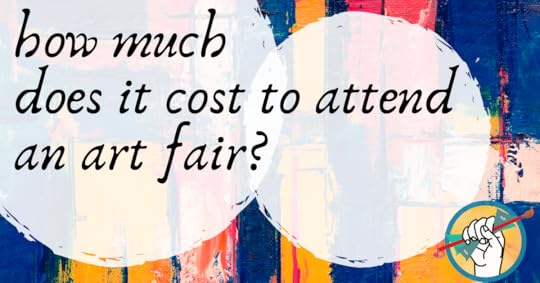
First Things First: Do Your Homework
Before you pay as much as an application fee, make sure that the show is a good fit for your artwork. Doing your homework up front can help prevent a lot of wasted time and money if the show is a dud or just not a good fit for you. Ask around: do you know anyone who has exhibited at this show? Do some Googling, and send emails or phone calls to artists who have exhibited. Do they advertise well, is the entry fee reasonable, is there ample parking? Is the show really about the artists, or is it more focused on music or food? Does the show cater to a certain art style or demographic?
Fees and Costs to Consider
Application/Registration Fees
This fee will depend on whether you are applying yourself, or whether a gallery that represents you is applying on your behalf. A gallery is likely to pay the application fee if they apply for you.
Not all shows charge an application fee, but knowing for sure will obviously mean the difference for you between being considered or not, so pay close attention to the application instructions. $35-$50 is a fairly standard range to expect for an application fee.
I spend about $100 on average for local monthly shows and about $400 on average for bigger regional shows – Adam Hall
Booth Fee
This fee will vary quite a bit from show to show. Here’s a sample of a booth fee breakdown for the La Quinta Arts Festival, one of the largest art festivals in the country:
The Standard Booth Fee – $275
The Large Booth Fee – $600
The X-Large Booth Fee – $800
The Booth Electric Fee – $150
Some shows, like La Quinta, also charge a percent commission on all sales made at the show (La Quinta’s commission is 20%).
Backdrops, Easels, & Display Hardware
Many art fairs allow or require a backdrop display like this one from Displays2Go for about $135.
[image error] [image error]
This is a one-time investment that would pay for itself quickly with the sale of a few prints or a single original, and will be useful whether the show is in a friend’s backyard or at a large regional exhibition.
You may need to purchase your own table(s), chairs/stools, easels, and hanging hardware. If exhibiting at an outdoor art fair you may also need to invest in a tent. Display easels are usually very portable and inexpensive (see some options for different kinds of easels: The Best Easels for Professional Painters.)
Tents and canopies can be a costly investment up front to the tune of $1,000 , but if art fairs are a proven part of your business model then it’s likely in your best interest to purchase one. For a first-time attendee, you’ll probably want to rent or borrow the larger elements of your display.
In local and regional shows the cost is between 15€ and 30€. But I have also done the big professional art salons ( huge indoor halls with stands and lighting provided) these cost 110€ tax. The average 9m square booth is around a 1000€. The first one I did was a disaster, but the second one made me over 4500€ so paid for my stand and accommodation and some of my losses on the previous salon, plus some income. My prices were in line with my Saatchi prices, so the cost of the stand / accommodation/ travel etc was taken into account. – Amanda Rackowe
Print Sales
Assuming you want to sell prints at the show, you’ll incur the up-front cost of purchasing or producing the prints. Unless you only bring prints that you already had in stock, prints will need to be factored into your budget. If you decide to use an online service to produce your prints for you, you have a lot of options with a wide range of prices. You can check out our list of print-on-demand options or our tutorial on how to create your own prints.
Travel/Food/Lodging
This will vary by region. It’s wise to arrange your travel accommodations as far in advance as you can, particularly if it’s a larger show. Especially if you are new to exhibiting at art fairs, be sure to factor in the costs of your daily meals, parking, and larger travel expenses into your overall budget.
Only two shows I want to go to. It would be $400 – $800. That does not include travel and a place to stay. – Kate Shaffer
Promotional Materials (Business cards, ad space, signage)
Investing in a good, well-designed banner or poster and a stack of business cards is a must. We highly recommend hiring a graphic designer if you aren’t one yourself.
Other resources:
Check out this free webinar on the 3 Most Important Tips for Selling at Art Shows
If you’re looking seriously into exhibiting at art shows, we highly recommend taking Owen Garratt’s course The Ultimate Guide to Profitable Art Shows. Use our special link for P off the regular price of this valuable course: https://pencilneck.thrivecart.com/art-shows-theabundantartistspecial/
Check out our list of the Top 9 Fine Art Shows in the Country
How much do you spend per art show, on average? Did we leave out any hidden costs? Let us know in the comments!
The post How Much Does it Cost to Attend an Art Fair? appeared first on Online Marketing for Artists.
January 30, 2019
Member of the Week: Marcela Diaz, Symbolic Art to Awaken the Soul
This week’s featured Association member is painter Marcela Diaz.
TAA: How would you describe your art to your ideal collector?
Marcela: Symbolic art to awaken your soul. I am portraying through my paintings the mystery and beauty of the human existence and promoting kindness as a way of living.
TAA: What motivates you during slow seasons?
Marcela: If I understand well you refer as slow seasons to a low selling time, I just think on that time as a precious time to paint more and experimenting without the pressure of selling, for me it is as a time to sow.
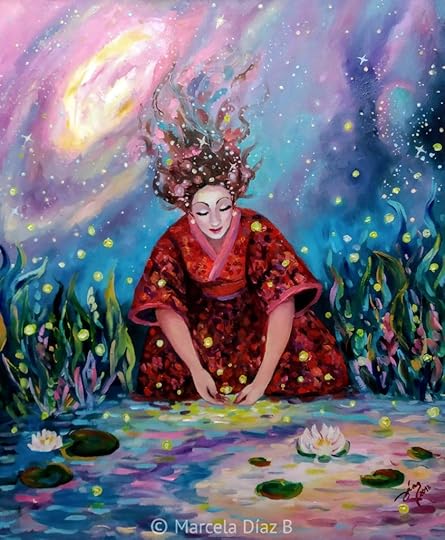
TAA: How did you settle on your current way of working? (How did you narrow your focus?)
Marcela: I start applying the 50/50 rule (50% painting /50% marketing), setting a schedule and more important of all is start working on series with a clear idea behind.
TAA: What is one mistake you’ve learned an important lesson from in your business?
Marcela: That it’s not all about you, it´s about your audience. First I thought that you paint something and you put it in front of everyone and wait for someone who like it and want to buy. But it is not like this, you have to give value first, people buy the artist not the art so they need to know you and feel a connection with you first. I understand now why people buy art. It is because our product is “emotion”, they don’t buy a painting, they buy emotion.
TAA: What was your greatest success from the past year?
Marcela: I sold a painting before it was completed dried just because I connected emotionally with people, just suddenly happened and I understood why and how to get that result again.
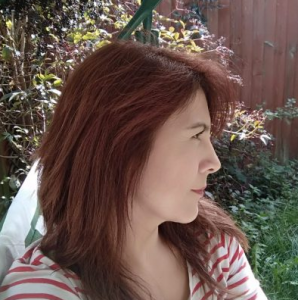 Marcela Diaz was born in Santiago de Chile, and growing up she loved art and handicrafts. She resisted studying art in college due to the stigma versus other more “legitimate” pursuits. She worked as an arts teacher and a mother for more than 10 years before moving to London with her family and deciding to pursue painting. It has not been easy but it has been worth it, because now she has the opportunity to gradually leave behind the ghost of the “starving artist” for good. You can see her art at http://marceladiazartstudio.com
Marcela Diaz was born in Santiago de Chile, and growing up she loved art and handicrafts. She resisted studying art in college due to the stigma versus other more “legitimate” pursuits. She worked as an arts teacher and a mother for more than 10 years before moving to London with her family and deciding to pursue painting. It has not been easy but it has been worth it, because now she has the opportunity to gradually leave behind the ghost of the “starving artist” for good. You can see her art at http://marceladiazartstudio.com
The post Member of the Week: Marcela Diaz, Symbolic Art to Awaken the Soul appeared first on Online Marketing for Artists.
January 25, 2019
Member of the Week: Ingrid vanReenen, Creating Lasting Memories of Beloved Pets
TAA: How would you describe your art to your ideal collector?
Ingrid: If you have stumbled across my website, it is my feeling that you likely have a love for animals, as I do. My pets are not my whole life, but they make my life whole. It is because of this that I have developed a passion for creating lasting memories of beloved pets. It would be my hope that a personalized portrait of your pet would be a memory to last for years to come.
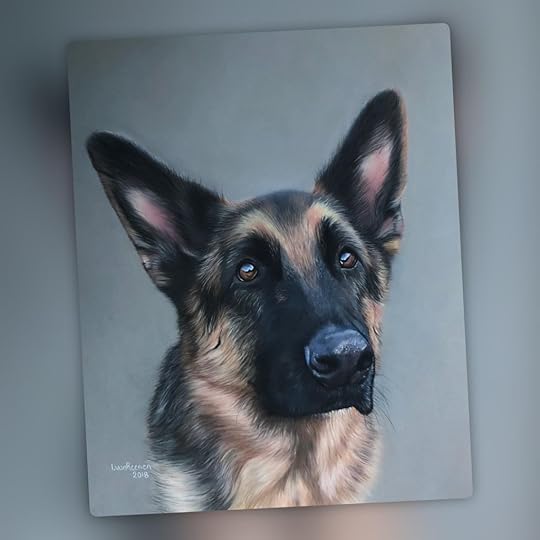 TAA: What motivates you during slow seasons?
TAA: What motivates you during slow seasons?
Ingrid: I truly feel motivated by the passion I have for animals and doing what I love to do!
TAA: How did you settle on your current way of working? (How did you narrow your focus?)
Ingrid: I believe that I naturally grew into doing what I do now. I started creating portraits of animals, because I love animals. I think that people could see my passion and love through my work, and because of this, they wanted me to create portraits of their animals. It has grown from there!
TAA: What is one mistake you’ve learned an important lesson from in your business?
Ingrid: I would say the biggest mistake I’ve made is undervaluing my work and time. I put so much effort into each piece and for some reason often did not feel worthy of asking enough money for them!
TAA: What was your greatest success from the past year?
Ingrid: I would say my greatest success has been growing my Facebook following and engaging with others! I have had consistent commissions all year and have enjoyed sharing them and receiving positive feedback.

Ingrid lives in the country outside of the small town of Cayuga in Ontario, Canada and has had a love of animals for as long as she can remember. She understands the important role that our pets play in our lives and is excited to be able to share her love of animals through her art work.
After studying Math and Science in University, followed by a degree in Education, Ingrid began dabbling in photography and later drawing in soft pastel. She enjoys looking for the small details that make each pet unique and conveying those in her work. You can see more of Ingrid’s work at http://ingridvanreenen.com
The post Member of the Week: Ingrid vanReenen, Creating Lasting Memories of Beloved Pets appeared first on Online Marketing for Artists.
January 23, 2019
Basic Sales Skills: Active Listening
Why do artists need basic sales skills? Isn’t that the job of the gallery? We know by now that the art sales landscape is shifting significantly (link). Traditional galleries are increasingly giving way to online stores and less conventional ways of selling art like artist cooperatives. Even if you are represented by a gallery now, that could change in the future. And if you have no idea how to sell your own work, you could be left in a critical lurch.
Basic sales skills come down to representing yourself and your brand with confidence and competence. The cornerstones of sales are confident body language and understanding how to ingratiate yourself to your customer with honesty and storytelling. On the flipside of this, and just as important, is the skill of active listening.
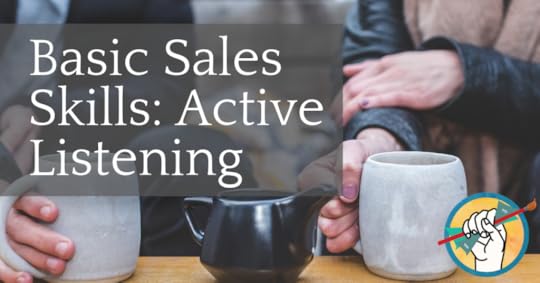
What is active listening and why is it important?
Sure, you’re the star of your art show. But you still have to communicate to your customers that you care about them and hear what they’re saying, otherwise you may come across as arrogant rather than simply confident. Active listening helps to ingratiate you with your customer, to let them know that you’re trustworthy and compassionate, and it makes them more willing to enter into a relationship with you and become repeat clients in the future.
The kind of listening we’re talking about is sometimes referred to as Active Empathic Listening, or AEL. There are three essential tasks for the active listener:
Sensitivity to the speaker’s feelings and to the subtext of the conversation and body language.
Processing what’s being said and restating or rephrasing it back to the speaker periodically.
Responding with verbal/physical acknowledgements of listening and understanding, and asking questions when useful.
What happens if you aren’t actively listening?
If you aren’t actively listening, you won’t remember what your customer said, which means you can miss out on valuable opportunities to communicate to them in an authentic way why they should buy your art. Not only that, but your face and body language is sure to betray your disinterest, losing the sale..
How to start actively listening
Increase your sensitivity
A huge part of active listening is understanding body language and facial expression. Make paying attention to the body language and expressions of others a daily practice: while you wait in line at the grocery store, when picking up your kids from school, sitting in the corner of a coffee shop, etc. You can take it to the next level by keeping notes. Do a little eavesdropping on conversations for context, and make notes of the body language you see and how it corresponds to the emotions being displayed.
It might feel a little weird to sit and watch people and write down what their eyebrows do when they are uncomfortable. But it’s just a way to train your mind to start paying attention. This is a helpful practice for artists of all disciplines!
Sharpen Your Processing
Processing is really just about making sure you understand what’s being said. Our brains process everything automatically, but whether you really understand comes down to how hard you’re paying attention. This is where restating and re-phrasing is extremely useful, not just for your own understanding, but to show the speaker that you are listening.
You can start practicing this with your very next conversation. When the speaker finishes a thought, say something like “so what you’re saying is xyz,” or “let me make sure I understand: you think such-and-such.” Restating what they’ve said is a great way to invite them to correct any errors in your understanding, and communicate that not only are you listening to them actively, but also that you care about what they’re saying.
Practice Responding
This is where you really want to think about your own body language. How are you communicating your interest with your hands, your arms, your eyes? Are your arms crossed defensively in front of you, or are they a little more open? Are you looking around the room, or are you making eye contact with the speaker? Are you nodding on occasion and giving little verbal encouragements that you’re listening (mmhmm, right, go on?) Or are your eyes glazed over with boredom? If you can get over the silliness of it, you can practice in a mirror. Or better yet, before your next art show recruit a friend and ask them to give you feedback on the way you react physically and verbally when they talk to you.
How can artists in particular be successful with active listening?
Artists are often very emotional and empathetic by nature. You see little details about the world that others miss, and this can be a tremendous advantage for you when it comes to developing a trusting rapport with your customers. You can use your knowledge of the importance of active listening as a chance to study others and use that as research to improve your business and your work.
To learn more about reading body language and communicating confidence, be sure to check out Vanessa Van Edwards’ Science of People.
The post Basic Sales Skills: Active Listening appeared first on Online Marketing for Artists.
January 18, 2019
Member of the Week: Beth Picard, Whimsical & Diverse Celebrations of Women
This week’s featured Association member is painter Beth Picard.
TAA: How would you describe your art to your ideal collector?
Beth: My artwork is a reflection of things I love. Color. Happiness. Whimsy. There is more though. Both my “Wild Women” and “Smoking’ Hot Women” series represent the diversity of women. We are different colors, we like different things, we have different careers. We are strong, independent, silly, courageous, outrageous, and maybe a little rebellious and do things that aren’t embraced by everyone. I want my paintings to remind women to be true to themselves and not apologize for who they are, how they look, dress, what their mood is or what they choose to do. I want women to be able to see themselves (or who they wish to be) in my paintings, while adding a little color and fun to their surroundings.
TAA: What motives you during slow seasons?
Beth: I am not saying that it doesn’t get hard during slow times, but I HAVE to paint and I do it every day, seven days a week. I also, always practice the art of abundance. I “talk” to my paintings as I paint, telling them that the “perfect” person is going to come along and love them. Not to say there are not times when the paintings pile up around my studio, but it seems that when I need it most, someone will email or contact me wanting a painting.
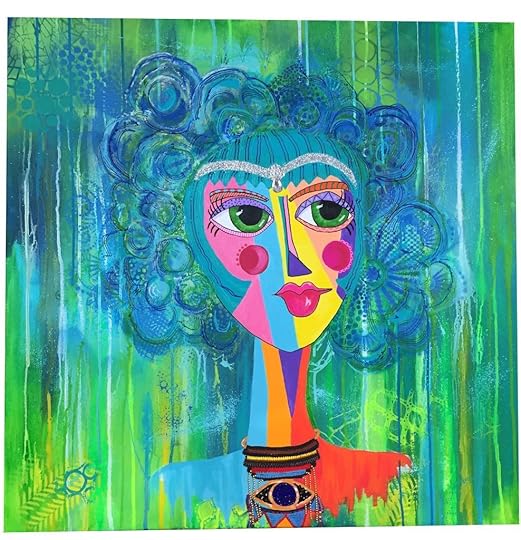 Serena the Seer, by Beth Picard
Serena the Seer, by Beth PicardTAA: How did you settle on your current way of working?
Beth: Right before I turned sixty, almost two years ago, I decided I was going to paint for ME. I have painted or done design work most of my life based on what I thought would sell. Maybe it is getting older and not caring so much what people think, but once I started painting what I wanted to paint and not caring what people thought, I blossomed. I have sold more since then and at higher prices than ever before- plus I am HAPPY and having FUN!
TAA: What is one mistake you have learned an important lesson from in your business?
Beth: These goes along with the above- Don’t do what you think will “sell.” Do what YOU want to do. Do it the way YOU want to do it. Believe in yourself to the point of ridiculousness and be happy doing what you are doing- it shows in your work.
TAA: What was your greatest success from the past year?
Beth: My greatest success this year was doing a painting as a homage to Ashley Longshore. Over the last few years I have followed her on Instagram and she is the Queen of Positivity for artists. She constantly encourages you to do what you want to do, don’t let people get you down, and believe in yourself, and she has the success to prove it works. It took me over a month and a half to paint (only taking 2 days off- otherwise painting 7-8 hours a day), it was the largest painting I have ever done, 4′ x 5′ and I painted people, something I had never done before- at least not where they had to actually look like who they were. It was a labor of love and gratitude. I really didn’t think she would even see it, but when I posted it on Instagram, she and members of her team responded within five minutes. AND… she wanted to buy it. And she did. Selling a painting to one of the hottest artists on the planet was a defining moment because I do BELIEVE all she says and it does work. It may be my greatest success of all time, I may never have another moment as glorious as that, but that is okay. I believe other great things will happen, but I can’t think of what could top that!
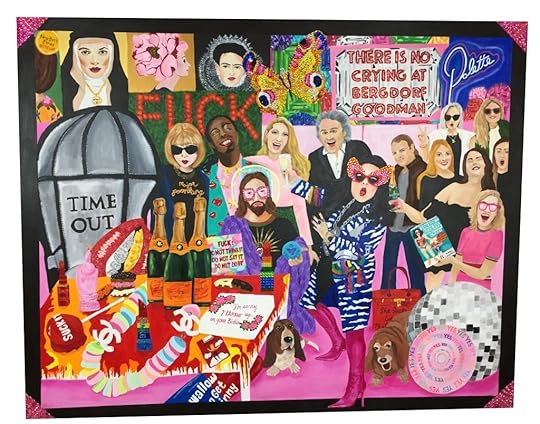 Ashley Throws a Party, by Beth Picard
Ashley Throws a Party, by Beth Picard
 Beth Picard has been creating art for a very long time, but just closed a very profitable online business to focus on painting full time in 2017. She has run several successful art-related businesses over the years, including creating the invitations for the White House Correspondent’s Dinner After Party, which was hosted by the Ambassador of Columbia and actress, Kerry Washington in 2007. You can see her art and learn more about her at her website, BethPicard.com.
Beth Picard has been creating art for a very long time, but just closed a very profitable online business to focus on painting full time in 2017. She has run several successful art-related businesses over the years, including creating the invitations for the White House Correspondent’s Dinner After Party, which was hosted by the Ambassador of Columbia and actress, Kerry Washington in 2007. You can see her art and learn more about her at her website, BethPicard.com.
The post Member of the Week: Beth Picard, Whimsical & Diverse Celebrations of Women appeared first on Online Marketing for Artists.
January 16, 2019
Basic Sales Skills: What Artists Can Learn From a Door-to-Door Salesman
Every artist needs good sales skills to successfully sell their work. Understanding your unique value proposition is the first step, followed closely by practicing the right body language that will communicate confidence and competence to your potential buyers. These skills lay a great foundation upon which to build a trusting rapport with your customers. When you sell your work, you’re not just selling a piece of art; you’re selling yourself, and your collectors will not buy from you if they don’t trust you.
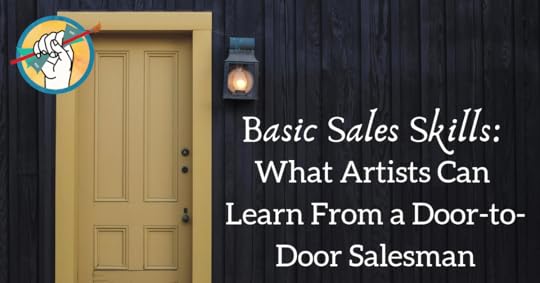
When you think of the word “trust” it’s unlikely that a door-to-door salesman immediately comes to mind. Pencil artist Owen Garratt of The Pencilneck, however, has broken the mold. He began his art career as a door-to-door salesman selling other people’s art to businesses, and what he learned about honesty and sales along the way has made him incredibly effective at selling his art. These principles have been condensed down from a much longer interview, which you can listen to here: What a $1 Million Art Business Looks Like With Owen Garratt.
Tell the Truth
When Owen was selling other people’s art door to door, he recognized the value of simply telling the truth. He recognized that, although it’s tempting, putting a fancy, salesy spin on the proposition wasn’t effective in the long term. In fact, rather than increasing sales in the long run, smooth talking and spinning the offer usually ends up hurting the customer’s trust. And though they may buy something in the moment, it’s usually just to get rid of the pushy salesperson.
A pushy, “salesy” strategy is an excellent way to kill your business, because it’s nearly impossible to create return customers when the only reason they buy something is to make you go away.
People love to buy, but hate to be sold. -Owen Garratt
The alternative? Just tell the truth.
I said “I represent this company and we’re doing a promotion for this artist, and we have a certain amount that we’re selling on promotion. And if you’d like them they’re regularly this price, we’re selling them for this price.” Which is true, that’s exactly what we were doing. But some people want to complicate it. -Owen Garratt
Ingratiate, then Educate
In a sales setting, leading with your pitch is a quick way to lose a customer. Nobody wants to have a sales pitch shoved in their face by a stranger. You must first build a rapport with your potential collector. This is why stories are so incredibly powerful: they’re an amazing way to ingratiate yourself with your collectors.
Owen Garratt is a master of telling fascinating and endearing stories. His website, and especially his blog, are his primary outlets for this knack for storytelling, although you’re likely to experience it in person as well. Although Owen seems to possess a natural penchant for entertaining, that doesn’t discount the fact that it’s also a carefully crafted skill, which he uses to ingratiate himself with new clients.
 Screenshot from Owen’s blog, The Pencilneck
Screenshot from Owen’s blog, The Pencilneck
It comes down to: people like stories. And… if you think back, chances are your best memories of high school, the teachers that you liked the best, weren’t the ones whacking the rulers on the desk and making you do your times tables over and over and over til you memorized them. There was an engagement there, there were stories, there was actual communication, and they made these subjects interesting. And there’s lessons in that example; you don’t have to be Tony Robbins. The world has one, and that’s good, that’s enough. It’s about finding who you are and finding a method of delivery. -Owen Garratt.
This may sound familiar if you’ve been reading along with our recent series on Basic Sales Skills. Body language expert Vanessa Van Edwards also believes that in order to sell effectively, every artist must find their own brand of charisma.
Once you’ve ingratiated yourself with your potential collector through your own charisma and storytelling, you can then educate them about your art: how do you make it? What inspires you? And most important of all: why do they NEED your art on their walls?
You don’t have to have any door-to-door selling experience to make a killing selling your art both online and in person. But in spite of his humble beginnings, Owen Garratt now runs a million-dollar art business. So you can take his word for it that telling the simple truth and making genuine connections with your clients through compelling storytelling will make a real difference in your ability to create -and keep- new customers.
Have you figured out how to tell your stories? If not, How To Sell Your Art Online 101 could change everything for you. Check it out here.
The post Basic Sales Skills: What Artists Can Learn From a Door-to-Door Salesman appeared first on Online Marketing for Artists.
January 11, 2019
Member of the Week: Nathan Brandner, Painting the Beauty of Everyday Life
This week’s featured Association member is painter Nathan Brandner.
TAA: How would you describe your art to your ideal collector?
Nathan: Grounded in reality, my paintings speak about the beauty that we find in our everyday lives. Portraits that celebrate the divine in each person. Landscapes that exemplify the serenity we find in our favorite locations. Still life that speaks to the nostalgia and timelessness of the things that we have familiarized ourselves with.
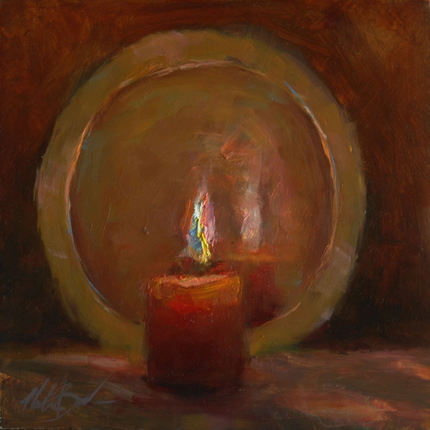 “Tender Light”, Nathan Brandner
“Tender Light”, Nathan BrandnerTAA: What motivates you during slow seasons?
Nathan: A slow season of sales is the perfect time to create massive amounts of work for the upcoming faster season of sales. A slow season of painting is time for more focus on reaching out to your audience and other people in your network. When things get slow and darkness creeps in I do my best to reflect on what I am grateful for and try to keep that at the forefront of my mind. Inspiration is all around us, I just need to choose to see it.
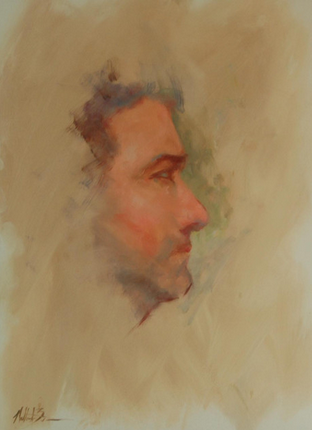 “Strength in Softness”, Nathan Brandner
“Strength in Softness”, Nathan Brandner
TAA: How did you settle on your current way of working?
Nathan: I worked with another fantastic artist who has helped me develop not only technical skills but a mindset for making work. That advice was “Make as much high quality work as you can.” So the way I work is often and to the highest quality I can. I am constantly studying the artists that inspire me and have had success in the past. I take workshops of living artists that inspire me as well. I am under the belief that my ability is a combination of all those I have studied, so I don’t need to worry about coming up with a “style.” Style as it is comes out of working constantly and absorbing as much as you can from what is around you.
Make as much high quality work as you can.
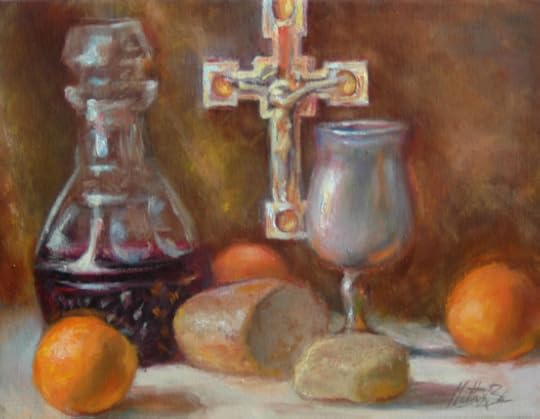 “Orange Blessings”, Nathan Brandner
“Orange Blessings”, Nathan Brandner
TAA: What is one mistake you have learned an important lesson from in your business?
Nathan: If you are going to commit to trying something new as far as a revenue stream, you need to make a plan to stick to it. I have bounced around too many ideas and dabbled with marketing plans here and there, only to not stick with them long enough to see if they work. I tried the daily painter thing and tried live streaming my art; both of those I gave up on way too quickly. There is no easy quick way to success. You need to stick to something for a while before determining its success.
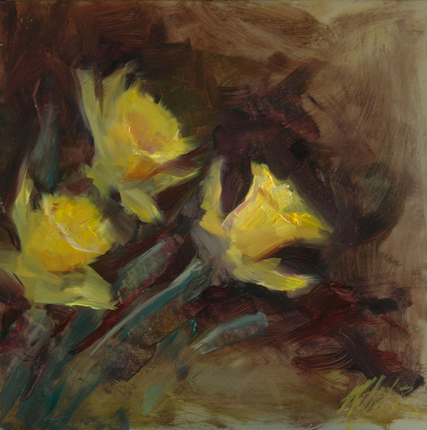 “Narcissus”, Nathan Brandner
“Narcissus”, Nathan Brandner
TAA: What was your greatest success from the past year?
Nathan: Selling work. I did some plein air competitions for the first time just to get out there and try something new. I was able to sell paintings at these competitions which was an absolute a thrill. Selling in general this year has been better than I ever imagined it would. Honestly knowing someone appreciates your work enough to bring it into their home and make it part of their life really brings joy to life.
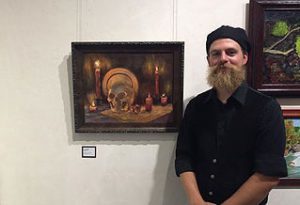
Inspired by the expressive colors of John Singer Sargent and the chiaroscuro of Rembrandt, Nathan is always seeking ways to create the breath of light and life in his works. Having been blessed to work under the likes of Ken DeWaard, Molly Johnson and Dan Gerhartz, he has learned many technical and philosophical aspects that have assisted him in arriving where he is today. You can see Nathan’s work at http://nathanbrandner.com.
The post Member of the Week: Nathan Brandner, Painting the Beauty of Everyday Life appeared first on Online Marketing for Artists.
The Abundant Artist Goodreads blog
- Cory Huff's profile
- 31 followers



